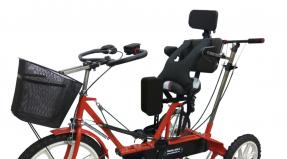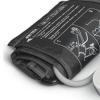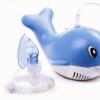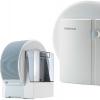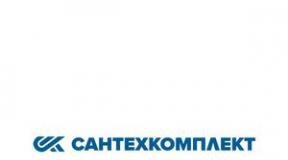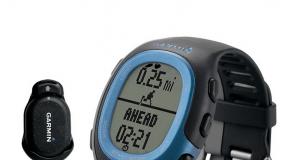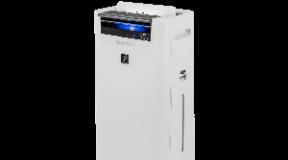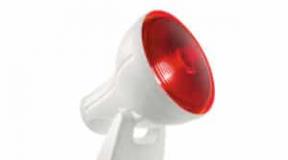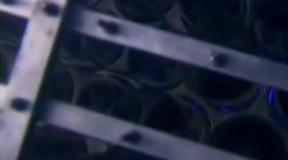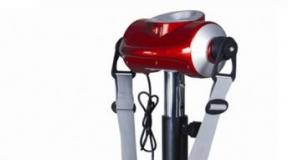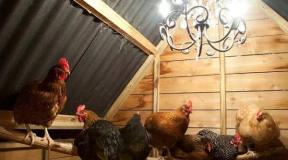New tools for building M-Bus networks. New tools for building networks M-Bus M bus description in russian
Teplopribor Group of Companies (GK) (Teplopribor, Prompribor, Teplokontrol, etc.) - these are devices and automation for measuring, monitoring and regulating the parameters of technological processes (flow metering, heat control, heat metering, control of pressure, level, properties and concentration, etc.).
At the manufacturer's price, products are shipped from both our own production and our partners - leading factories - manufacturers of instrumentation and automation, control equipment, systems and equipment for controlling technological processes - APCS (much is available in the warehouse or can be manufactured and shipped as soon as possible) ...
Dispatching with M-Bus and RS485
Below are two comparative examples of specifications for dispatching heat meters in an apartment building by wired scheme using M-Bus and RS485 interfaces:
1. Commercial offer with M-bus
Object - apartment building for 53 ultrasonic heat meters TSU-Du20:
1 entrance 10 floors, 1st floor non-residential premises, from 2 to 9 floors 6 apartments each, 2 water meters in the apartment, on the 10th floor 6 apartments, 2 water meters in the apartment
| A type | Qty | Unit price, rub. | Amount, rub. |
| Ethernet converter | 1 | 9 350,00 | 9 350,00 |
| Power supply IP | 1 | 3 630,00 | 3 630,00 |
| Mbus / RS485 converter | 1 | 7 160,00 | 7 160,00 |
| Total: | 20 140,00 | ||
| Including VAT 18% | 3 072,20 | ||
Total amount for commercial proposal with PC: 410,662.00 rubles.
Mbus based dispatching
2. Commercial offer with RS485 for the object
Object - apartment building for 53 ultrasonic heat meters TSU-Du20:
apartment building, 1 entrance 10 floors, 1st floor non-residential premises, from 2 to 9 floors with 6 apartments, 2 water meters in the apartment, on the 10th floor 6 apartments, 2 water meters in the apartment.
| A type | Qty | Unit price, rub. | Amount, rub. |
| Ethernet converter | 2 | 9 350,00 | 18 700,00 |
| Power supply IP | 2 | 3 360,00 | 7 260,00 |
| Total: | 25 960,00 | ||
| Including VAT 18% | 3 960,00 | ||
Total amount for commercial proposal with PC: 451,462.00 rubles.
* - The system unit (computer-PC) is supplied at the request of the customer.

RS485 based dispatching
Additional information on interfaces and protocols
1. The difference between M-Bus and ModBas
M-Bus interface (Meter-Bus) - Physical layer standard for fieldbus based on asynchronous interface. This name also refers to the communication protocol used to communicate devices over this bus. The M-bus interface is mainly used for metering devices for electrical energy (electricity meters), heat energy (heat meters), water and gas flow meters.
Modbus protocol - open communication protocol based on the master-slave architecture. It is widely used in industry to organize communication between electronic devices. It can be used to transfer data via serial communication lines RS-485, RS-422, RS-232, and TCP / IP networks (Modbus TCP). There are also non-standard implementations using UDP.
Do not confuse "MODBUS" and "MODBUS Plus". MODBUS Plus is a proprietary protocol owned by Schneider Electric. The physical layer is unique, similar to Ethernet 10BASE-T, half duplex over one twisted pair, speed 1 Mbit / s. The transport protocol is HDLC, over which an extension is specified for the transmission of a MODBUS PDU.
2. Difference between RS485 / RS422 interfaces from RS232 and USB
a) RS-485 interface
RS-485 interface (Recommended Standard 485), EIA-485 (Electronic Industries Alliance-485) is a physical layer standard for an asynchronous interface. It regulates the electrical parameters of a half-duplex multipoint differential communication line of the "common bus" type.
The RS-485 standard has become very popular and has become the basis for creating a whole family of industrial networks, widely used in industrial automation.
The RS-485 standard uses a single twisted pair of wires to transmit and receive data, sometimes accompanied by a braided shield or common wire.
Data transfer to RS485 is carried out using differential signals. The voltage difference between conductors of one polarity means a logical unit, the difference of the other polarity means zero.
Since the RS485 / 422 interfaces are implemented on differential communication lines, their noise immunity is very good. Typically, cable management is used with a wave impedance of 120 ohms. Terminating resistors must be installed at the ends of the lines. RS485 lines can be up to 1 kilometer long.
RS422 interface is a "lightweight" version of RS485. It has reduced output currents of the transmitters and therefore less load capacity. Data repeaters are used to improve these parameters.
The RS485 interface implements the trunk principle of data exchange. It can address up to 63 ports. Strictly speaking, RS422 is a radial interface, but many equipment manufacturers supplement it with the possibility of trunk connection and partial compatibility with RS485 (with reduced parameters in terms of load capacity).
b) RS232 interface
RS232 interface built on unipolar data lines. Therefore, its performance and maximum cable length are small. RS232 is used to connect peripheral equipment to control computers. RS232 is a radial interface, so the concept of an address is absent. These factors contribute to improving the efficiency of the interface in data acquisition systems and with peripheral equipment.
c) USB interface
USB (u-es-bi, eng. Universal Serial Bus - "universal serial bus") - a serial interface for connecting peripheral devices to computers. The USB interface has become widespread and has actually become the main interface for connecting peripherals to digital household appliances.
The USB interface not only allows data exchange, but also provides power to the peripheral device. The network architecture allows you to connect a large number of peripherals, even to a device with one USB connector.

The article is devoted to the M ‑ Bus communication protocol, designed to build an energy metering system, to the features of the architectural M ‑ Bus bus and ADFweb equipment for M ‑ Bus networks.
LLC "Krona", St. Petersburg
With all our love for freedom, we are already accustomed to the web entangling us. Networks of asphalt roads on the ground and wires in the air, the invisible Internet and a data collection system in production ... And each network has its own rules that allow you not to get confused in its intricacies, but to use it for your own good.
Why do you need another M-Bus protocol? The computer community involved in energy metering needs its own “game environment” optimized for meter reading. To control the consumption of energy resources, a specific network is needed - as simple and cheap as possible, allowing many slaves to be connected to the master, extending over several kilometers. A special protocol serves all these tasks.
M ‑ Bus ("Meter-Bus") is a European standard for building distributed systems for data collection and commercial metering of energy consumption (heat, water, gas, electricity, etc.).
The M ‑ Bus standard is described and approved by the normative documents EN ‑ 1434-3 (1997), GOST R EN ‑ 143403-2006 dated 01.09.06. Today this standard is supported by most of the leading manufacturers of energy metering devices and is increasingly used to solve energy metering problems in Russia.
The main advantages of the M ‑ Bus standard:
Ease of building a network;
High noise immunity;
The length of communication lines is up to several kilometers;
Simple network segmentation;
A large number of metering points;
Simplicity of phased network expansion;
Passive power supply for Slave devices;
Minimal costs for installation and operation of equipment.
M ‑ Bus architecture
The transmission medium for the M-Bus standard is twisted-pair copper, and there are no strict requirements for the network architecture. However, the developers of M-Bus equipment do not recommend using the “ring” architecture, as well as using loopback fragments for network segments.
On the other hand, the architecture of the M-Bus network can simultaneously include elements of the typology "bus" and "star", which allows you to create flexible and arbitrary network structures.
The communication protocol between devices on the M-Bus network is based on the principle "one master, many slaves". For each network segment, only one Master is required, which sends requests and receives a response from the Slave devices (maximum 250 devices for one segment). This completely eliminates the possibility of conflicts within the M-Bus network segment.
All slave devices are connected in parallel to the Master device via the M ‑ Bus (twisted pair) bus, and the polarity of the devices connected to the bus does not matter.
M ‑ Bus communication is serial in both directions. The bus is maintained at a nominal voltage level from the Master device to provide power to the Slave devices. To transmit the data bit, the master changes the voltage level on the bus, which is perceived by all slaves. Recognizing its address in the request, the authorized slave transmits data bits by modifying the current drawn from the M-Bus. These changes are read by the Master.
The physical length of the M ‑ Bus is limited by the active resistance of the wires, which, due to the current consumption of the slaves, reduces the supply voltage in the network as the distance from the master device decreases. The data transfer rate in M \u200b\u200b‑ Bus networks is limited by the electrical capacitance of the bus and ranges from 300 to 9600 baud. The limitation on the number of Slave devices in one network segment is determined by the voltage source power of the Master device and the maximum addressing capabilities - up to 250 devices.
However, despite all the advantages of the protocol, its use in dispatch control systems of ACS TP and AMR was until recently difficult for the following reasons:
A small selection of equipment for building M-Bus networks was presented on the market;
This equipment was too expensive;
There was a lack of reference and technical documentation.
This situation changed with the advent of ADFweb equipment on the domestic market, which specializes in the production of equipment for working with industrial protocols. At the end of 2010, the company presented a line of equipment for M-Bus networks. Information about these devices is presented in tables 1 and 2.
Protocol Description
M-Bus (Meter-Bus) - communication protocol (European standard EN 1434 / IEC870-5, EN 13757-2 physical and channel layers, EN 13757-3 application layer), based on the standard client-server architecture. One of the most common data transfer protocols for a number of specific electronic devices, such as electrical energy meters (electricity meters), heat energy meters (heat meters), water and gas meters, some executive devices, etc. Data is transmitted to a computer station (server) directly or through M-Bus hubs, signal repeater amplifiers.
Difference from Modbus protocols, RS-485 standard - other levels of logical signals, low speed data transmission (300 - 9600 bit / s), low requirements for the communication line, the ability to power devices from the M-Bus line, there are no requirements for polarity. Due to a number of features, the protocol is not an industrial protocol; it is used only in those devices where low speed and even loss of a part of the transmitted data are not critical. The advantages of the protocol include minimum requirements to equipment, communication lines, simplicity and speed of implementation, installation, which makes it low-cost and economically attractive.
Some parameters of the M-Bus protocol
- half-duplex transmission mode;
- data transfer rate 300-9600 bps (compatible with standard UART rates of PC and microcontrollers, which are the source and receiver of data);
- logical unit + 36V, current no more than 1.5 mA;
- logical zero 12..24V, current 10-11mA;
- standard telephone cable type (JYStY N * 2 * 0.8 mm);
- line capacity no more than 180 nF, resistance up to 29 ohms;
- transmission distance, in standard configuration, up to 1000 meters;
- range of the slave device to the signal repeater up to 350 meters;
- the number of devices on the line is up to 250.
Logic one is transmitted at 36V level, with the possibility of consumption from the current line up to 1.5 mA, logical zero is transmitted with 24V voltage on the master device. To transmit a logical zero, slave devices increase the current consumption to 10-11mA, a high current consumption and a decrease in voltage in the master line are detected by the device as logical 0. In this, the transmission protocol is similar to 1-Wire, both in the way of data transmission and the ability to power the devices from lines.
Notes on the M-Bus term
Wikimedia Foundation. 2010.
See what "Meter-Bus" is in other dictionaries:
Meter-Bus - For similarly named bus technologies, see MBus. M Bus (Meter Bus) is a European standard (EN 13757 2 physical and link layer, EN 13757 3 application layer) for the remote reading of gas or electricity meters. M Bus is also usable for other types…… Wikipedia
Buš - Buš… Deutsch Wikipedia
BÜS - Wappen Deutschlandkarte ... Deutsch Wikipedia
Recently, we have been paying great attention to the issues of connecting third-party devices to the ASUD-248 system.
This is due to the logical desire to integrate, within the framework of a unified dispatch control and management system, engineering subsystems that ensure the operation of the serviced objects.
Connected devices can be, for example, heating and ventilation controllers, heat energy and water meters, various sensors, actuators, etc.
A third-party device is connected to the ASUD-248 system via a specific physical interface, data exchange occurs according to a set of rules supported by the device: a protocol.
They often operate with the concepts of M-bus, Modbus, RS-485, Ethernet, Computer network, etc. - some of which define the physical interface for connecting devices, and others a set of data transfer rules.
When communicating with design organizations, customers who are directly faced with the task of connecting third-party devices to the ASUD-248, you often encounter confusion in the definitions of "interface", "protocol" and related questions, for example:
- "Is Modbus an interface?"
- "Modbus and M-bus are the same"
- "The device has RS-485 - can it be guaranteed to be connected to the ACS?" etc.
It should be noted that in essence the terms "interface" and "protocol" express the same concept - a description of the procedure for interaction between two objects. This fact, in our opinion, in the field of the topic under consideration, can also lead to some ambiguity.
Therefore, for definiteness, let us agree to understand the interface as the physical (hardware) interface - the data transmission medium. Under the protocol - a set of described rules for transferring data over one or another interface.
RS-485
RS-485 is an interface. It defines the requirements for the communication line (cables), regulates the electrical parameters of the communication line and other parameters associated with signal transmission from one device to another.
RS-485 says nothing about the rules of data exchange between devices.
Consequently, the mere fact that a third-party device has an RS-485 interface is not enough for a guaranteed connection to the ACS. It is necessary to clarify the data exchange protocol.
RS-232
RS-232 is also an interface (similar to RS-485).
Modbus
Modbus is a communication protocol widely used in industry. It defines the rules for transferring data when communicating between devices.
We can implement dispatching and control of almost any device, if it supports this protocol.
There are several modifications of this protocol:
- Modbus RTU.
- Modbus TCP / IP.
- Modbus ASCII (currently not supported in ASUD-248).
The word "Modbus" itself does not say anything about the interface between devices.
Modbus protocol can work over RS-485 / RS-232 interfaces, computer network and others.
Therefore, if it is known that the device supports the Modbus protocol, it is necessary to clarify what physical interfaces the device has and whether they are supported in the ASUD-248.
For details on connecting Modbus devices, see
M-Bus
The situation is somewhat different with M-Bus.
First of all, it should be noted that despite the consonance in the Russian transcription, M-Bus has nothing to do with the Modbus protocol.
The term M-Bus can mean both a physical interface and a data transfer protocol at the same time.
Usually, M-Bus support is implemented only in metering devices: heat meters, electricity meters, water meters, etc.
If it is indicated that the meter supports M-bus, you should always clarify what you mean:
- physical interface only
- physical interface and protocol (usually)
- only protocol.
Those. the device can support the M-bus protocol, but the connection interface is, for example: RS-485. Or the device has an M-bus interface, but the device developers have implemented their own exchange protocol. In this case, to connect to ASUD-248, it is necessary to agree on the exchange protocol.
For details on the M-Bus connection, see p.
The development of high technologies simplifies the work of modern services, including in the utilities sector. The need for a person to take readings from the meters and transfer them to the control point is completely eliminated by the introduction of the m-bus system, which organizes a full-fledged modern control room that receives readings in automatic mode. The standard is approved by the normative documents of 1997 EN-1434-3 and GOST of 2006 EN-1434-3-2006. The system has become widespread in Eastern and Western Europe. With its help, readings from water, heat, gas, electricity meters in residential and industrial buildings are organized.
Organization of a dispatch network for taking readings from meters
The European standard m-bus is a system for collecting data from energy metering devices. Using this standard, it is possible to organize the collection of data on the flow rate recorded by meters from hundreds of devices. For this, cable systems are laid - m-bus, to which the device is connected.
The m-bus system has clear advantages that make it possible to use it to create appropriate dispatch networks:
- Ÿstable transmission of information from a large number of non-proactive sources over distances of up to several kilometers;
- Ÿthe system is inexpensive, and also does not require large costs for its installation and operation;
- Ÿthe system is easily restructured and supplemented with new data sources;
- Ÿ allows you to perform a complete cut of the real state of meter readings, taking data from many sources simultaneously;
- Ÿ readings are easily taken from devices located in hard-to-reach places;
- Ÿthe system can be optimized according to customer requirements.
M-bus protocol
System data is transmitted using anti-jamming protocolm— bus... This protocol is used in the scheme one master - many slaves. Each segment of the network uses one master that directs requests and receives a response from each device. This arrangement avoids network conflicts. Data is transferred over the bus in serial mode. To transmit a data bit, the master changes the bus voltage. Each of the devices listens for this signal, knowing which one is receiving the request. The device being accessed transmits data bits in response, changing the bus voltage, which the master reads.
M-bus master
The m-bus master is the central device that controls the operation of the network. The m-bus master can be a computer or other device that stores data from the devices and sends signals for data retrieval. The m-bus master also powers the devices via a cable connection. The system can additionally include various sensors (pressure, temperature, smoke), which are also powered by the m-bus master.
Bus and hub in the m-bus network
In the m-bus network, it is possible to read data from a large number devices. However, it is impossible to lay a cable from the server to each of the devices, so an m-bus hub is used in the network, which unites many devices and then connects directly to the dispatcher's computer or to the Internet. The hub also acts as an archiver. Without it, the m-bus system takes the current meter readings, and with the hub it is possible to take the readings saved by the device. This device is controlled from the dispatcher's computer and organizes the data transfer from the devices, storing the information from them and sending them by signal to the control computer. There are hub models for 25, 60 or 250 subscribers. Hubs can act as a repeater, so it is possible to build a network of several hubs, subordinate to which other hubs are built, which have their own subscribers.
Data is transmitted via copper twisted pair - m-bus. The device can be connected to the bus using a telephone cable 2x0.75 mm2, the length of which can be 1-5 meters. Depending on the remoteness of the dispatching computer, the RS232 / USB interface is used to connect the hub to a computer or modem. Limitations on the length of transmission cables are caused by the increasing resistance of the conductor, depending on the increase in length. Changes in the voltage level in the bus, which is a signal during data transmission, is difficult. Also, the number of connecting Slave devices is limited. The maximum number can be 250. How quickly data is transferred in the network depends on the electrical capacity of the bus. It is usually in the range 300-9600 bps.
Repeaters used to expand the network usually provide visually information about network congestion. There is an indication on the devices, through which you can determine the mode of operation and the possibility of adding devices. For example, on the Hydro-Center 60/250 / Memory repeater, m-bus indication can be in the following modes:
- Ÿ green means up to half of the tire load;
- Ÿyellow - the bus load exceeds 100%, the device is operational, but a warning is issued that it is unacceptable to supplement the network with more devices;
- Ÿred - this is a critical overload of the device. It must be rebooted and checked for serviceability.
Converters for m-bus network
 The m-bus network interface uses 36V. Devices connected to the network, equipped with other interfaces (for example, RS232, RS485) operate at different voltages, so special converters must be installed in front of them. Converting voltage levels. An example of such a device is the m-bus 10 converter. Such an m-bus converter allows you to connect up to 10 metering devices. He works like a master on the network. The device contains indicator diodes that indicate power status and data transmission mode. Also, converters are used in systems where you need to convert and transfer data from a network that works in m-bus to a system that transmits telemetry data, for example, SCADA. NPE-Modbus is used as such a device.
The m-bus network interface uses 36V. Devices connected to the network, equipped with other interfaces (for example, RS232, RS485) operate at different voltages, so special converters must be installed in front of them. Converting voltage levels. An example of such a device is the m-bus 10 converter. Such an m-bus converter allows you to connect up to 10 metering devices. He works like a master on the network. The device contains indicator diodes that indicate power status and data transmission mode. Also, converters are used in systems where you need to convert and transfer data from a network that works in m-bus to a system that transmits telemetry data, for example, SCADA. NPE-Modbus is used as such a device.
Meters with the ability to transfer data over the network
Energy metering devices used in m-bus systems are equipped with a special module. Heat meters including such a module can be of two types. In the first type, the m-bus module is built into the device, in the second it is optional. The module is a printed circuit board that supports the data transfer function. The presence of such a module must be noted in the passport of the device. The bus wires are connected to the screw terminals of the meter. The maximum possible diameter of the connected wires is 2.5 mm, and the bus voltage is no more than 50V.
Read also ...
- Water ionizer - how to choose?
- Does the belly massager help with weight loss El slimming massager with hands
- Cheerful nebulizer Kit: advantages and disadvantages, analogues
- Body massager VitaImpuls manual electric vibration massage apparatus with heat radiation Vita Impulse Show instructions vita impulse with heat


